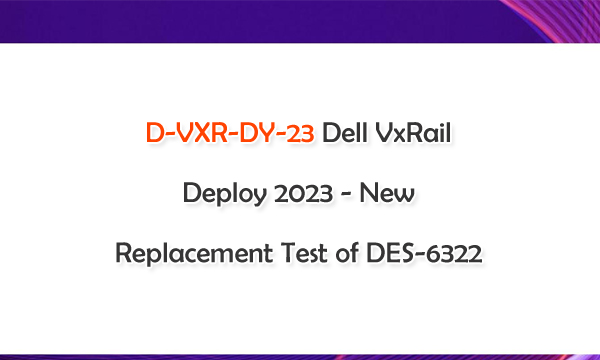D-VXR-DY-23 Dell VxRail Deploy 2023 - New Replacement Test of DES-6322
D-VXR-DY-23 Dell VxRail Deploy 2023 exam is the new replacement test of DES-6322, which has been retired. The Dell VxRail Deploy 2023 D-VXR-DY-23 exam is one for individuals seeking validation of their skills in deploying and managing VxRail environments. Hyperconverged solutions, such as VxRail clusters, are designed to simplify IT operations and reduce operational costs. The VxRail Deploy 2023 certification focuses on enabling individuals, whether internal staff or partners, to understand and implement VxRail clusters seamlessly. Successful candidates will not only grasp the fundamentals of the product but also gain expertise in the extended VxRail environment.

Dell VxRail Deploy 2023 Certification Requirements
To attain the Dell VxRail Deploy 2023 certification, candidates must meet the following prerequisites:
1. Knowledge and Skill Set: Develop a robust knowledge base and skill set through hands-on product experience or by completing the recommended training.
2. Exam Success: Successfully pass the D-VXR-DY-23 Dell VxRail Deploy 2023 Exam.
D-VXR-DY-23 Exam Structure
The D-VXR-DY-23 exam is divided into two segments, each with specific duration and pass score requirements:
- Part 1: Duration: 90 minutes (~50 questions), Pass Score: 63%
- Part 2: Duration: 30 minutes (~6 simulations), Pass Score: 66%
A successful outcome is imperative in both parts for an overall certification achievement.
D-VXR-DY-23 Dell VxRail Deploy 2023 Exam Topics
The D-VXR-DY-23 exam encompasses an extensive range of topics related to VxRail deployment and management. Here's a succinct overview of the key areas:
1. Introduction to VxRail (8%): Explore VxRail use cases, architecture, models, and the software stack. Understand VxRail management, licensing, and data protection options.
2. VxRail Deployment Planning (7%): Delve into vCenter server options, physical switches, NIC configurations, DNS options, vSphere Distributed Switch features, and node discovery options.
3. Using VxRail Configuration Tools (7%): Master the creation of VxRail projects and configurations, and review completed configurations for implementation.
4. VxRail Hardware Installation and Initialization (8%): Comprehend VxRail system racking and cabling procedures, and configure VxRail Node iDrac and System Time.
5. VxRail Network Environment Requirements and Initialization (13%): Configure VxRail network settings and validate the network environment manually or using the Network Validation Tool.
6. Deploying the VxRail Cluster (13%): Generate implementation procedures and execute VxRail initialization with both internal and external vCenter Servers.
7. VxRail Post-Deployment Procedures (18%): Validate post-installation, implement licenses, configure vSAN settings, and establish native backups.
8. VxRail Cluster Upgrade and Expansion (8%): Understand upgrade requirements, scale-out best practices, and the cluster expansion process.
9. VxRail Troubleshooting (10%): Acquire skills to perform VxRail log collections, utilize troubleshooting resources, and troubleshoot using vSAN tools.
10. VxRail REST API (8%): Identify REST API functionality available in VxRail and leverage it to perform tasks.
Practice Dell VxRail Deploy 2023 D-VXR-DY-23 Exam Dumps
- Related Suggestion
- Updated DELL EMC DES-6322 Exam Dumps in October October 14,2021

